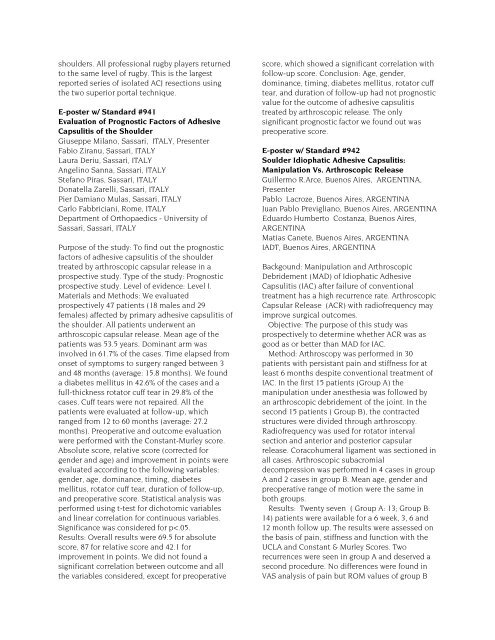POSTER ABSTRACTS - ISAKOS
POSTER ABSTRACTS - ISAKOS
POSTER ABSTRACTS - ISAKOS
Create successful ePaper yourself
Turn your PDF publications into a flip-book with our unique Google optimized e-Paper software.
shoulders. All professional rugby players returned<br />
to the same level of rugby. This is the largest<br />
reported series of isolated ACJ resections using<br />
the two superior portal technique.<br />
E-poster w/ Standard #941<br />
Evaluation of Prognostic Factors of Adhesive<br />
Capsulitis of the Shoulder<br />
Giuseppe Milano, Sassari, ITALY, Presenter<br />
Fabio Ziranu, Sassari, ITALY<br />
Laura Deriu, Sassari, ITALY<br />
Angelino Sanna, Sassari, ITALY<br />
Stefano Piras, Sassari, ITALY<br />
Donatella Zarelli, Sassari, ITALY<br />
Pier Damiano Mulas, Sassari, ITALY<br />
Carlo Fabbriciani, Rome, ITALY<br />
Department of Orthopaedics - University of<br />
Sassari, Sassari, ITALY<br />
Purpose of the study: To find out the prognostic<br />
factors of adhesive capsulitis of the shoulder<br />
treated by arthroscopic capsular release in a<br />
prospective study. Type of the study: Prognostic<br />
prospective study. Level of evidence: Level I.<br />
Materials and Methods: We evaluated<br />
prospectively 47 patients (18 males and 29<br />
females) affected by primary adhesive capsulitis of<br />
the shoulder. All patients underwent an<br />
arthroscopic capsular release. Mean age of the<br />
patients was 53.5 years. Dominant arm was<br />
involved in 61.7% of the cases. Time elapsed from<br />
onset of symptoms to surgery ranged between 3<br />
and 48 months (average: 15.8 months). We found<br />
a diabetes mellitus in 42.6% of the cases and a<br />
full-thickness rotator cuff tear in 29.8% of the<br />
cases. Cuff tears were not repaired. All the<br />
patients were evaluated at follow-up, which<br />
ranged from 12 to 60 months (average: 27.2<br />
months). Preoperative and outcome evaluation<br />
were performed with the Constant-Murley score.<br />
Absolute score, relative score (corrected for<br />
gender and age) and improvement in points were<br />
evaluated according to the following variables:<br />
gender, age, dominance, timing, diabetes<br />
mellitus, rotator cuff tear, duration of follow-up,<br />
and preoperative score. Statistical analysis was<br />
performed using t-test for dichotomic variables<br />
and linear correlation for continuous variables.<br />
Significance was considered for p
















